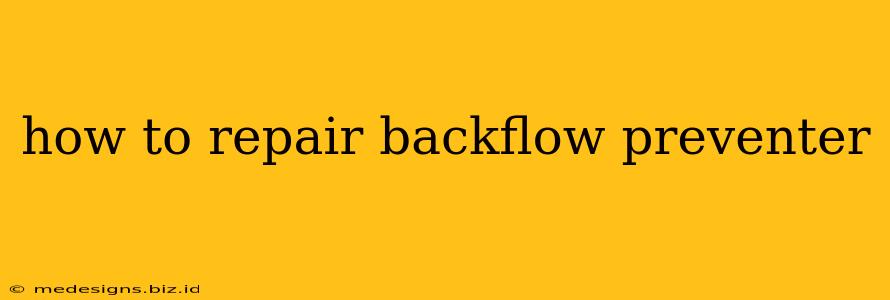Backflow preventers are crucial components of your plumbing system, safeguarding your drinking water from contamination. But like any mechanical device, they can malfunction. Understanding how to repair a backflow preventer can save you money and ensure the safety of your water supply. However, it's crucial to remember that attempting complex repairs without the proper knowledge and tools can cause more harm than good. This guide will walk you through the basics, but for major issues, always consult a licensed plumber.
Understanding Backflow Preventers
Before diving into repairs, let's quickly understand what a backflow preventer does. It's a valve that prevents contaminated water from flowing back into your clean water supply. This contamination can come from various sources, including:
- Backpressure: Pressure surges in the main water line.
- Cross-connections: Accidental connections between your clean water and contaminated water sources (e.g., garden hose).
There are different types of backflow preventers, each with its own complexity. The most common types include:
- Double Check Valve (DCV): A relatively simple device with two check valves that prevent backflow.
- Reduced Pressure Zone (RPZ) Backflow Preventer: A more complex device with multiple components designed to prevent backflow under various conditions.
- Pressure Vacuum Breaker (PVB): A simpler device suitable for low-pressure applications, typically used for outdoor faucets.
Common Backflow Preventer Problems and Basic Repairs
While some repairs require professional expertise, certain minor issues can be addressed with a little DIY know-how. Always turn off the water supply before attempting any repairs.
1. Leaking Check Valves
A leaking check valve is a common problem, often indicated by a dripping sound or water leakage near the valve. For a Double Check Valve (DCV):
- Identify the leaking valve: Carefully inspect each check valve for visible signs of leakage.
- Tighten the valve: If the leak is minor, try tightening the valve's packing nuts. Do this gently to avoid damaging the valve.
- Lubrication: Sometimes, lubrication can improve the seal and reduce leakage. Use a plumber's lubricant designed for this purpose.
2. Clogged Check Valves
Debris can accumulate and clog the check valves, hindering their operation.
- Inspect for debris: Visually inspect the valve and its components for any visible obstructions.
- Clean the valve: If debris is present, carefully attempt to remove it. However, if you cannot easily access the internal components, calling a plumber is recommended.
3. Low Water Pressure
Low water pressure after the backflow preventer can be due to several factors:
- Clogged Filter: Many backflow preventers have a filter. If it's clogged, it can restrict water flow. Clean or replace the filter according to the manufacturer's instructions.
- Air in the Line: Air trapped in the lines can also restrict water flow. Try opening faucets to release trapped air.
When to Call a Plumber
While minor repairs might be feasible for DIY enthusiasts, many issues necessitate professional intervention. Call a licensed plumber immediately if:
- You're unsure about the problem or how to address it.
- The backflow preventer is severely damaged or leaking significantly.
- You're dealing with an RPZ or other complex backflow preventer.
- The backflow preventer is a critical component of a commercial or industrial system.
Annual inspections by a licensed plumber are highly recommended to ensure your backflow preventer is functioning correctly and to identify any potential problems before they become major issues.
Regular maintenance and timely repairs are key to the longevity and efficient operation of your backflow preventer. By understanding the basics and knowing when to seek professional help, you can protect your water supply and avoid costly repairs down the line.
